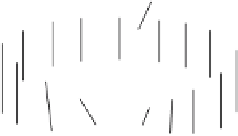Graphics Reference
In-Depth Information
The map F is called a
vector bundle isomorphism
if f is a homeomorphism and
˜
is a
vector space isomorphism on each fiber (or, equivalently,
˜
is a homeomorphism
between
E
1
and
E
2
). We say that x
1
and x
2
are
isomorphic
vector bundles, and write
x
1
ªx
2
, if there exists a vector bundle isomorphism between them. An n-plane bundle
x=(
E
,p,
B
) that is isomorphic to the product bundle (
B
¥
R
n
, projection onto
B
,
B
) is
called a
trivial vector bundle
.
Clearly, if F = (
˜
,f ) is a vector bundle isomorphism, then F
-1
= (
˜
-1
,f
-1
) is a vector
bundle isomorphism called the
inverse
of F. One can also compose vector bundle
maps.
Now, one way of thinking of vector bundles is as locally trivial bundles with fiber
a vector space, that is, if x is an n-plane bundle over a space
B
, then there will exist
a covering of
B
by open sets
U
, so that x|
U
is trivial. To put is yet another way, an n-
plane bundle over a space
B
consists of a collection of product bundles (
U
¥
R
n
,pro-
jection onto
U
,
U
) for open sets
U
in
B
that are glued together along their fibers using
maps in GL(n,
R
). We shall make this clearer later when we discuss the tangent bundle
of a manifold. The generalization of this way of looking at a vector bundle is what is
called a
fiber bundle
(also written
“fibre” bundle
) where we allow an arbitrary space to
be the fiber except that one is also explicitly given a group which acts on the fibers.
In our case, this group would be GL(n,
R
).
Returning to the topic of cross-sections, an interesting question is whether or not
a vector bundle has a nonzero cross-section. Trivial bundles (other than the 0-dimen-
sional ones) certainly have lots of nonzero cross-sections. In fact, a trivial n-plane
bundles has n linearly independent cross-sections (Exercise 8.9.1). Therefore, a vector
bundle that has no nonzero cross-section cannot be trivial and this becomes one of
the tests for triviality.
It is time to give an example of a nontrivial vector bundle.
8.9.2. Example.
Our nontrivial vector bundle is easy to describe in rough terms,
although it will take a little more work to explain rigorously. Basically, we are talking
about an “
open” Moebius strip
thought of as the total space of a line bundle (
E
,p,
S
1
)
over the circle. See Figure 8.29. In a sense, we are simply removing the boundary of
meridian
E
p
S
1
Figure 8.29.
The open Moebius strip line bundle.








